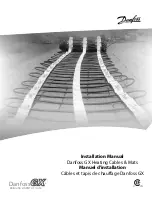
TFP223
Page 4 of 6
Care and
Maintenance
The Series EC-8 Sprinklers must be
maintained and serviced in accordance
with this section.
Before closing a fire protection system
main control valve for maintenance
work on the fire protection system that
it controls, permission to shut down the
affected fire protection systems must
be obtained from the proper authorities
and all personnel who may be affected
by this action must be notified.
Sprinklers that are found to be leaking
or exhibiting visible signs of corrosion
must be replaced.
Automatic sprinklers must never be
painted, plated, coated, or other-
wise altered after leaving the factory.
Modified sprinklers must be replaced.
Sprinklers that have been exposed to
corrosive products of combustion, but
have not operated, should be replaced
if they cannot be completely cleaned
by wiping the sprinkler with a cloth or
by brushing it with a soft bristle brush.
Care must be exercised to avoid
damage to the sprinklers before,
during, and after installation. Sprin-
klers damaged by dropping, striking,
wrench twist/slippage, or the like, must
be replaced. Also, replace any sprin-
kler that has a cracked bulb or that has
lost liquid from its bulb. (Ref. Installa-
tion Section.)
Frequent visual inspections are rec-
ommended to be initially performed
for corrosion resistant coated sprin-
klers, after the installation has been
completed, to verify the integrity of the
corrosion resistant coating. Thereafter,
annual inspections per NFPA 25 should
suffice; however, instead of inspecting
from the floor level, a random sampling
of close-up visual inspections should
be made, so as to better determine the
exact sprinkler condition and the long
term integrity of the corrosion resistant
coating, as it may be affected by the
corrosive conditions present.
The owner is responsible for the
inspection, testing, and maintenance of
their fire protection system and devices
in compliance with this document, as
well as with the applicable standards
of the NATIONAL FIRE PROTECTION
ASSOCIATION (e.g., NFPA 25), in
addition to the standards of any other
authorities having jurisdiction. The
installing contractor or sprinkler man-
ufacturer should be contacted relative
to any questions.
It is recommended that automatic
sprinkler systems be inspected, tested,
and maintained by a qualified Inspec-
tion Service in accordance with local
requirements and/or national codes.
1/4" (6,4 mm)
3/4" (19,1 mm)
9/16±1/4"
(14,3±6,4 mm)
CLOSURE
1-5/16" (33,3 mm)
13/16" (20,6 mm)
MOUNTING
SURFACE
FACE OF
SPRINKLER
FITTING
2-1/4" DIA.
(57,2 mm)
2-7/8" DIA.
(73,0 mm)
MOUNTING
PLATE
1/8"
(3,2 mm)
1/4" (6,4 mm)
1/2" (12,7 mm)
MOUNTING
SURFACE
FACE OF
SPRINKLER
FITTING
7/16±1/8"
(11,1±3,2 mm)
2-1/4" DIA.
(57,2 mm)
2-7/8" DIA.
(73,0 mm)
CLOSURE
1-5/16" (33,3 mm)
1-1/16" (27,0 mm)
MOUNTING
PLATE
1/8"
(3,2 mm)
"FITTING SIDE"
TOWARDS SPRINKLER
FITTING
WRENCH
RECESS
(END "A")
WRENCH
RECESS
FIGURE 2
SERIES EC-8 RECESSED PENDENT SPRINKLER ASSEMBLY
WITH TWO-PIECE 1/2 INCH TOTAL ADJUSTMENT
STYLE 30 RECESSED ESCUTCHEON
FIGURE 3
SERIES EC-8 RECESSED PENDENT SPRINKLER ASSEMBLY
WITH TWO-PIECE 3/4 INCH TOTAL ADJUSTMENT
STYLE 40 RECESSED ESCUTCHEON
FIGURE 4
W-TYPE 3
SPRINKLER WRENCH
FIGURE 5
W-TYPE 23 RECESSED
SPRINKLER WRENCH
























